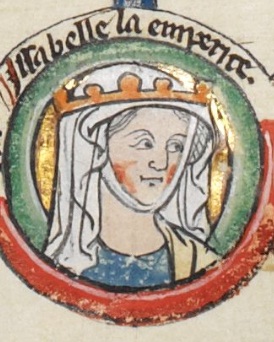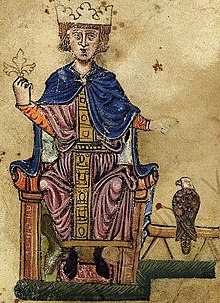by Susan Flantzer © Unofficial Royalty 2017

Isabella of England, Holy Roman Empress, Queen of Sicily; Credit – Wikipedia
Born in 1214, Isabella was the second daughter of the three daughters and the fourth of the five children of King John of England and Isabella of Angoulême.
Isabella had four siblings:
- King Henry III of England (1207 – 1272), married Eleanor of Provence, had five children including King Edward I of England
- Richard, Earl of Cornwall, King of the Romans (1209 – 1272), married (1) Isabel Marshal, had three sons and a daughter, only one son survived childhood, Isabel died in childbirth (2) Sanchia of Provence, had two sons, only one son survived childhood (3) Beatrice of Falkenburg, no children
- Joan of England (1210 – 1238), married Alexander II, King of Scots, no children
- Eleanor of England (1215 – 1275), married (1) William Marshal, 2nd Earl of Pembroke, no children (2) Simon de Montfort, 6th Earl of Leicester, had seven children

13th-century depiction of King John and children, (l to r) Henry, Richard, Isabella, Eleanor, and Joan; Credit – Wikipedia
On October 18, 1216, when Isabella was only two years old, her father King John died leaving his elder son Henry, a nine-year-old, to inherit his throne amid the First Barons’ War (1215–17), in which a group of rebellious barons supported by a French army, made war on King John because he refused to accept and abide by the Magna Carta. In July 1217, Isabella’s mother Isabella of Angoulême left England, returning to France to assume control of her inheritance in the County of Angoulême, basically abandoning her children by King John. In 1220, Isabella of Angoulême married Hugh X of Lusignan, Count of La Marche with whom she had nine children, who were Isabella’s half-siblings. Two-year-old Isabella was left in charge of her nurse Margaret Bisset.
Around 1225, Isabella’s brother King Henry III held negotiations for two possible marriages for Isabella, with Heinrich who was the eldest son of Friedrich II, Holy Roman Emperor, and with King Louis IX of France. However, both marriage projects failed. By 1228, Friedrich II, Holy Roman Emperor, and King of Sicily had been widowed twice. In 1234, Friedrich met with Pope Gregory IX who suggested that he marry Isabella. Pope Gregory IX hoped such an alliance would promote a new English-German Crusade. Friedrich wished for more legitimate sons and also saw the marriage as a step towards promoting peace in Europe.

Friedrich II, Holy Roman Emperor; Credit – Wikipedia
In November 1234, Friedrich sent a delegation to England to negotiate a marriage contract. Friedrich agreed to give Isabella land in Sicily and Italy, in return for a dowry of 30,000 silver marks. Count Heinrich II of Virneburg, Archbishop of Cologne and Henri I, Duke of Brabant arrived in London at Easter 1325 to escort Isabella to her groom. William Briwere, Bishop of Exeter headed up the English contingent escorting Isabella. On May 11, 1235, Isabella tearfully said goodbye to her brother King Henry III, and embarked for Antwerp where she arrived four days later. Isabella was met at Antwerp by numerous armed nobles who escorted her to Cologne, fearful of an abduction of the bride by order of King Louis IX of France. Isabella spent about six weeks in Cologne.
In the beginning of July, escorted by the Archbishop of Cologne and the Bishop of Exeter, Isabella started her week-long journey to the city of Worms to meet her groom. 40-year-old Friedrich was immediately charmed by his 21-year-old bride. On July 15, 1235, in Worms Cathedral in the presence of clergy, nobility, dukes, and kings, Isabella of England married Friedrich II, Holy Roman Emperor and was crowned Holy Roman Empress, Queen of Germany and Sicily.

The wedding of Isabella and Friedrich II, Holy Roman Emperor; Credit – Wikipedia
After four days of wedding festivities, Isabella and Friedrich left for their honeymoon at the Imperial Palace in Haguenau, Alsace (now in France). It was at this point that Isabella had to say her farewells to the English contingent. Only two of her ladies were allowed to remain, her nurse Margaret Bisset and her servant Katherine. Isabella rarely appeared in public and had no political influence. She lived in seclusion mostly at the castle in Noventa Padovana, near Venice and Padua in present-day Italy.
There is controversy over how many children Isabella and Friedrich had, but they had at least four children:
- Jordanus (born and died 1236)
- Agnes (born and died 1237)
- Heinrich (1238 – 1254), unmarried
- Margarethe (1241 – 1270), married Albrecht, Margrave of Meissen, had issue
Isabella died in Foggia, Kingdom of Sicily, now in Italy, at the age of 27 on December 1, 1241, after giving birth to her last child. She was buried at Andria Cathedral in Andria, Kingdom of Sicily, now in Italy, next to her husband’s second wife Queen Isabella II of Jerusalem (Yolande of Brienne), who also died after childbirth.

Crypt of Andria Cathedral where Isabella is buried; Photo Credit – Von Linx – Eigenes Werk, CC BY-SA 3.0, https://commons.wikimedia.org/w/index.php?curid=15921842
This article is the intellectual property of Unofficial Royalty and is NOT TO BE COPIED, EDITED, OR POSTED IN ANY FORM ON ANOTHER WEBSITE under any circumstances. It is permissible to use a link that directs to Unofficial Royalty.
Works Cited
Abrufstatistik. “Isabella von England.” Wikipedia. N.p.: Wikimedia Foundation, n.d. Web. 1 Jan. 2017.
“Frederick II, Holy Roman Emperor.” Wikipedia. N.p.: Wikimedia Foundation, 30 Nov. 2016. Web. 1 Jan. 2017.
“Isabella of England.” Wikipedia. N.p.: Wikimedia Foundation, 13 Feb. 2016. Web. 1 Jan. 2017.
Susan. “Isabella of Angoulême, queen of England.” British Royals. Unofficial Royalty, 23 Aug. 2016. Web. 31 Dec. 2016.
Williamson, David. Brewer’s British Royalty. London: Cassell, 1996. Print.
